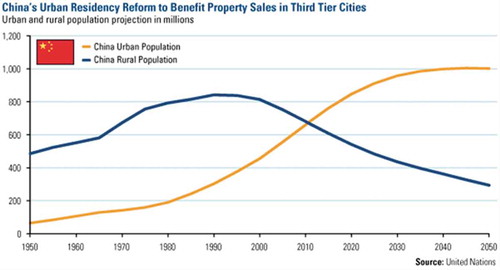 ?Mathematical formulae have been encoded as MathML and are displayed in this HTML version using MathJax in order to improve their display. Uncheck the box to turn MathJax off. This feature requires Javascript. Click on a formula to zoom.
?Mathematical formulae have been encoded as MathML and are displayed in this HTML version using MathJax in order to improve their display. Uncheck the box to turn MathJax off. This feature requires Javascript. Click on a formula to zoom.ABSTRACT
Designing with Nature is an approach linking design and ecology, which focuses on living with nature, caring for nature, and aiming for a sustainable society. China has made eco-city development, eco-restoration, and eco-civilization its legislative priority and its national strategy, investing a US$618 billion in a 5-year period from 2011–2015 that could reach as high as US$1,124 billion dollars in the period of 2016–2020. “Designing with nature” also means that we must, as we are dealing with resources, consider and understand all the impacting factors and ecosystem capacities. China’s biggest challenge has been to restore water quality, aquatic ecosystems, and landscape patterns. Alongside its natural resources and eco-city development, China possesses a solar energy capacity higher than that of any other country in the world, reaching 174 gigawatts by 2018. Solar power is now cheaper than fossil fuels in hundreds of Chinese cities. In this review, we affirm that the nature-driven design put forth by McHarg’s Design with Nature has withstood the test of time, and we aim to renew interest in McHarg’s ideas by arguing for a design of Chinese cities that is, in keeping with Design with Nature, future-oriented, nature-oriented, and sustainability-oriented.
The year of 2019 marks the 50th anniversary of the publication of Ian L. McHarg’s book Design with Nature (McHarg Citation1969). Many of the philosophical ideas and detailed techniques McHarg wrote about are now ecological common sense and practice; however, fifty years later, we still have a way to go before we understand nature and we achieve a fully nature-driven design, particularly in China. Certainly, we need to chart how the book has influenced design on six topic areas of ecosystem restoration, resource conservation, landscape patterns, eco-city development, eco-architecture, and society, with which McHarg was most concerned, but we must also assess what has been done in the last 50 years in those areas, as human beings are facing many great challenges such as global warming and pollution, and how we go from here with key actions and recommendations supported by our ecological design and eco-city development in China.
Nature and ecosystems
In the last fifty years, the valuation and preservation of nature have been the core issue for ecological development and sustainability. Designing with Nature is a book linking design and ecology, which focuses on living with nature, caring for nature, and aiming for a sustainable society (Lu, Nebojsa, and Anne-Sophie Citation2015). This year is the 40th anniversary of the establishment of the Ecological Society of China (ESC). Owing to the efforts of ESC and increased environmental consciousness across the world, China has made eco-city development, eco-restoration, and eco-civilization its legislative priority and its national strategy. By realizing the importance of “lucid water and lush mountain” (Wang et al. Citation2019), China committed to protect natural forest reserves, restore its forest ecosystems, and increase the forest coverage rate from 8% in the late twentieth century to 22.6% recently. In particular, we are advocating the use of “Sponge City Design” in more than 100 cities in China (Wu Citation2016). A “Sponge City” is one whose infrastructure passively absorbs, filtrates, and preserves rainfall in an ecologically friendly way that reduces soil and water erosion and polluted runoff. In our design, we promoted the development and restoration of city wetland parks, forest parks, and rain gardens, which opened new and natural possibilities for city ecosystems based on historical and natural topography. Based on historical extremes of rainfall recorded in a city, especially under the impact of global warming, we recommended and set the flood zone usually within 3–11% of the total area of the region. We were able to then set the safe construction elevation for city development above the maximum level of predicted flooding ().
Figure 1. Setting a mean water surface elevation (M.W.S.E.) and safe construction elevation (S.C.E.) for city development based on historical and nature topography in the design area (13.48 km2) of Dongpo Wetland in Meishan City, Sichuan Province, China.
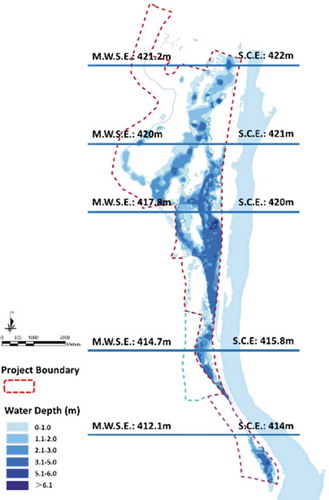
Fifty years ago, McHarg deeply concerned the deterioration of the ecosystem and environment. To tackle the crisis of environmental deterioration, China invested US$618 billion in a 5-year period from 2011–2015 (Bright Energy Citation2018) and could reach as much as US$1,124 billion dollars in the period of 2016–2020 (China News Network Citation2018) to re-design and restore different ecosystems nationwide. As a result, every year 1980 square kilometers of desertificated lands were restored and a total of 479 natural reserves nationwide were established (China Economics Network Citation2017). But the function, structure, and service of the ecosystems on which we rely remain urgently in need of protection, restoration, redesign, and investment. In our design, we focused more on native vegetation and species, natural community structures and spatial patterns, biodiversity and habitats, and ecosystem boundaries and area. We also targeted increased ecosystem service value and profitability for each ecosystem restoration project by comparing the Equivalent Factor (EF) per unit area (hectare) of ecosystem service values (Xie et al. Citation2015) before and after the restoration of the Fuhe Watershed in Wuhan City, Hubei Province, China. Following the implementation of our design, the EF increased 34.5% from 197,958.16 to 266,312.30 ().
Table 1. Comparison of the Equivalent Factor (EF) per unit area (hectare) of ecosystem service values before (a) and after (b) restoration of the Fuhe watershed in Wuhan City, Hubei Province, China.
Ian McHarg advises city developers against taking rich soil or sand from areas at risk of becoming “biological deserts.” It is with this same logic that China is promoting “Sponge City Design” for all its urban ecosystems, integrating the concept with that of “low-impact development” to form a natural spatial pattern in cities toward the preservation of water resources, such as lakes and ponds, wetlands and forests, gardens and green parks, and water quality. The improvement of the city environment creates a suitable living environment for its residents and contributes to global ecological security. For example, Jinan City has finished more than 250 sponge engineering projects and improved more than 200 communities’ life quality and living environment by preventing water and soil erosion, minimizing water runoff, and maximizing green areas (Wu and Swain, Citation2018).
Nature and resources
For McHarg, nature is defined, in opposition to humanity and human creations, as the physical world and its usable resources. Although Taoist religious practices have mediated the Chinese relationship with nature for 1,800 years, many have nonetheless treated nature as an inexhaustibly exploitable resource. Owing to the last 40 years of economic growth, resource shortage, especially water shortage, has become a bottleneck for China’s economic development. We have found that resource shortage could be caused by either one of the factors or a combination of factors including ecosystem capacity, use efficiency, technology, finance, pollution, and ecological sustainability. Therefore, “designing with nature” means that we must, as we are dealing with resources, consider and understand all the impacting factors and ecosystem capacities.
One of the methodological challenges of “designing with nature” concerns how we determine the appropriate area of water and wetland in which to preserve water resources and prevent water pollution from runoff. The total area determined for Qingdao is related to the annual total rainfall (775.6 mm), maximum continuous rainfall (269.6 mm), maximum high tide (5.36 m, a.s.l.), surface runoff intensity (150 cm/s), and runoff patterns (). In forests, 50% of the rainfall will be preserved in shallow and deep groundwater, compared to the 15% in cities like Qingdao. To preserve water from runoff, we created a new lake called Lake Jinhu with 7.3 km2 in area and water depth greater than 6.0 m, preserving more than 22 million cubic meters of runoff water for Qingdao City (). Certainly, topography, soil type, vegetation type, urban spatial pattern, wetland, water ecology, water economy, water environment, water pollution, flood control, drought prevention, and many other factors must be considered comprehensively within the watershed as a whole.
Figure 2. Runoff patterns for natural forest, rural, and urban area, compared to a mega-city like Qingdao, with differing percentages of runoff, evaporation, and seepage into shallow and deep groundwater (Baidu Data Citation2013).
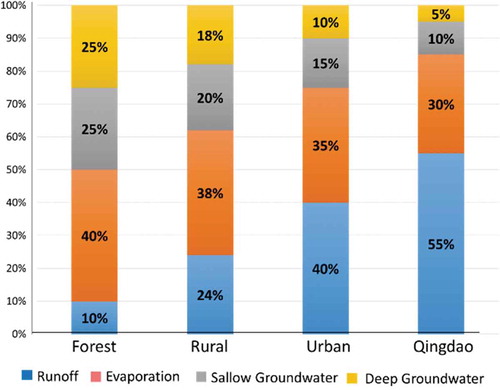
Figure 3. By mimicking natural runoff patterns in the forest to create a new lake, Lake Jinhu, we preserved more than 22 million cubic meters of runoff water in Jiaozhou Bay, Qingdao, China.
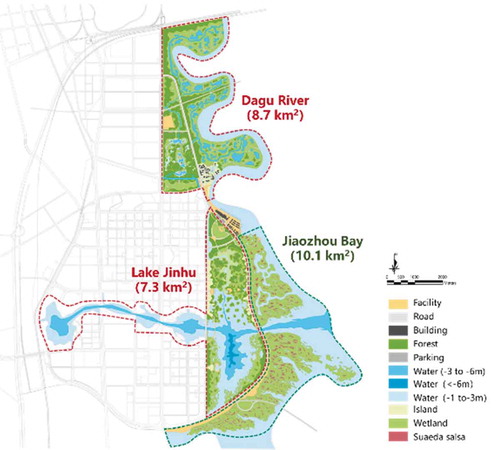
Nevertheless, water shortage remains a challenge all over China. China’s total water resource number about 2.81 trillion cubic meters, in which surface water resources are 2.71 trillion cubic meters, and groundwater resources are 0.1009 trillion cubic meters (China Economics Network Citation2017), accounting for 6% of the world’s water resources and ranking sixth in the world after Brazil, Russia, Canada, the United States, and Indonesia. However, with all the water resources, the economically, ecologically, and technically feasible water resource capacity for China is only 0.80 trillion cubic meters, accounting for about 28% of total water resources (Liu and Chen Citation2001). As a result, China’s per capita water resource is about 2300 cubic meters, only one-fourth of the world’s average level (Wang, Huang, and Xie Citation2016). As China is rapidly becoming a developed-world economy, China accounts for the largest water consumption in the world. In 2018 alone, the consumption of freshwater in China reached 0.62 trillion cubic meters, accounting for 77.5% of China’s total water resource capacity and about 13% of the world’s annual consumption, which is about 127% that of the United States. Among all the water use, agricultural use in 2018 amounted to about 0.38 trillion cubic meters, taking 61.3% of the total annual usage (CEIC Citation2018; Chou et al. Citation2018).
After 40 years of rapid economic development, China is facing severe resource constraints, serious environmental pollution, and ecosystem degradation. We have come to the critical moment where we must establish the concept of ecological civilization that respects and protects nature, conforms to natural resource capacity, and upholds the approach of sustainable development. Prioritizing conservation, protection, and natural restoration and striving to promote green development, China is undergoing “The Greater Yangtze River Watershed Ecological Protection Planning,” which will cost an estimated US$1.6 trillion and generate US$5.7 trillion increase in ecosystem service, economic development, and social life quality (Chen et al. Citation2017; Wu and Liu Citation2016). In China, eco-civilization also means clean energy and low-carbon development based on national renewable energy plan. The installed capacity of wind power added to the grid was 20.59 gigawatts in 2018, the year in which the total installed capacity of wind power in China had reached 184 gigawatts, ranking first in the world for nine consecutive years (Dudley Citation2019). China possesses a solar energy capacity higher than that of any other country in the world, reaching 174 gigawatts by 2018 (Chou et al. Citation2018). Solar power is now cheaper than fossil fuels in hundreds of Chinese cities (Guangfu Network (Citation2018)).
Nature and landscape
The amount of total investment needed to complete watershed restoration and water resource preservation in China will cost as much as an estimated US$680 billion dollars (China News Network Citation2019). Our water preservation team created a design to restore landscape patterns back to natural river structures, restoring flats, banks, beds, waterways, ponds, lakes, and natural flow. Instead of stretching the river and constructing flood control levees, we turned all the large flood zones into natural wetlands and lakes to prevent flooding and to maximize water resources. Our biggest challenge was to restore the water quality, which required restoring the aquatic ecosystem and re-directing all the wastewater into wastewater treatment plans. Since most of the wetland vegetation would not sustain the effluent from wastewater treatment plant, we successfully designed a series of landscape patterns such as honeycomb-pond-systems to reestablish the aquatic ecosystems with natural hydrodynamics and to support the wetland ecological function, achieving Category III in water quality in the long run (Wu and Swain Citation2018).
For a wetland landscape design that restores the aquatic ecosystem and the landscape pattern, we used the Lacunarity index (Wu, Wang, and Rutchey Citation2006) to mimic the natural landscape patterns, such as (EquationEquation 1(1)
(1) ),
where (r = 2) is the size of a landscape gliding box across a landscape, S is the number of cells of a given landscape type within the gliding box, and Q(S, r) is the corresponding frequency of a given landscape type occurring in the landscape gliding box.
As Lacunarity indexλ(r) varies between 1.75 and 4.85 in natural wetlands (Wu, Wang, and Rutchey Citation2006), we used these Lacunarity index numbers for our design of coastal wetland patterns in Jiaozhou Bay, Qingdao, China (). ) presents the design layout of the coastal wetland pattern, and ) presents the design sketch for the wetland.
Figure 4. Using Lacunarity index numbers of natural wetlands for our design of coastal wetland patterns in Jiaozhou Bay, Qingdao, China: (a) design layout and (b) the design sketch of the coastal wetland pattern.
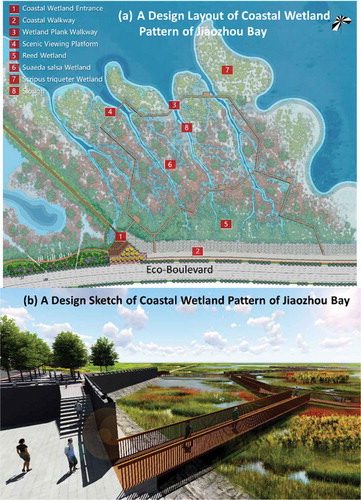
The Lacunarity index renders the landscape pattern measurable, comparable, and designable. It also serves as an index for mimicking natural landscape patterns under different spatial and temporal scales. The index can help us understand why we have to design with nature and how to design with nature, that is, to restore the natural landscape patterns.
One purpose of “designing with nature” is to restore landscape patterns, which can help to restore the water quality. We not only use the Lacunarity index to mimic natural landscape patterns, but we also use the water quality model (EquationEquation 2(2)
(2) , Equation3
(3)
(3) , Equation4
(4)
(4) ) to examine water quality (i.e., total phosphorus–TP, total nitrogen–TN, and chemical oxygen demand – COD) for different landscape patterns to make sure that is the landscape pattern we need. The water quality model can be expressed with TP, TN, or COD concentrations (mg/L) before and after water runs through different landscape patterns:
Then integrated as:
Become:
In which:
CO beginning concentrations at t0 (mg/L);
Ct concentrations at time x tx (mg/L);
k concentration coefficients per day (d−1);
t responding time in days (d);
The Liulihe River in Beijing is a river with a dry riverbed, more likely a linear wetland with 22,000 m3/d of treated wastewater from two treatment plants. Based on the input water quality (COD > 60, TP > 1.5, TN >15 mg/L), we designed 5 different landscape patterns using our water quality model to simulate the different deduction rates (%) of COD, TP, and TN in different wetland landscape patterns. The results suggested that with different landscape patterns, COD concentration may deduct 87.1%, TP 83%, and TN 83.9% ()
Figure 5. Five different landscape patterns using our water quality model (EquationEquation 2(2)
(2) , Equation3
(3)
(3) , Equation4
(4)
(4) ) to simulate the different deduction rates (%)of COD, TP, and TN in different landscape patterns of Liulihe wetland, Beijing, China.
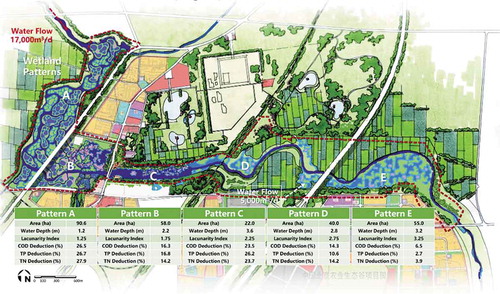
Nature and eco-city
An eco-city is an ecologically healthy city, a sustainable city, an energy-efficient city, a low-carbon city, a smart energy city, and an ecosystem whose structure and function are self-sustaining and resilient. The World Bank (Citation2018) defines eco-cities as “cities that enhance the well-being of citizens and society through integrated urban planning and management that harness the benefits of ecological systems and protect and nurture the natural assets for future generations.” The need for laws and regulations that keep humans safe in the city should also apply to keeping the natural environment safe. For eco-city development, China has committed to two major acts: firstly, eco-civilization and, secondly, “Sponge City Design,” which visualizes the city landscape as a sponge absorbing water, for the purposes of water preservation and floor prevention (Ecocity Builders Citation2018; Wu Citation2016).
In 1982, China began to accept the concept of urban ecology. China’s eco-city development was initiated in 2003 with a resolution to make the Beijing-Tianjin metropolitan area an urban ecosystem (Baidu Data Citation2015). Initiated at the Fifth International Ecocity Conference on Aug. 18–23, 2002, Shenzhen, China, by delegates from SCOPE/ICSU, the Society for Human Ecology (SHE), the International Ecological Engineering Society (IEES), the International Society for Ecology (INTECOL), Ecocity Builder (ECOCITY) and the International Society for City and Regional Planners (ISoCaRP), the International Council on Ecopolis Development (Intecoppolis) was established in Sept. 2006. Since then, Intecopolis has been applying an ecological perspective to China’s urbanization and environmental issues. In 2015, China recognized its top 10 eco-cities (out of 284 cities at the prefecture level and above): Zhuhai, Xiamen, Zhoushan, Sanya, Tianjin, Huizhou, Guangzhou, Fuzhou, Nanning, and Weihai. Based on the case study, it is predicted that China’s urbanization rate will reach 70% by 2030 (, US Global Investors, Citation2012), and the construction of eco-cities is steadily advancing. As a result, the eco-city is the only model for the development of urbanization in China that integrates economic and social concerns with those of nature, information, and the efficient utilization of energy and material resources, for a livable home and a quality life. As a leading nation in eco-city development, China is reported to start a design and development of the world’s first “Forest City,” or “Eco-City,” which will run on renewable energy, plant 40,000 trees, and absorb nearly 10,000 tons of CO2 and 57 tons of pollutants yearly (Futurism Citation2017).
Coal has been the economic engine of Huaibei, Anhui Province, China, and the most defining characteristic of its current identity. The cumulative extraction and production over 50 years have made a great contribution to the development of this city and China, while also causing significant environmental degradation within about 30 km2 of subsided mining area. Self-emulated in urbanization and eco-city development, it is now undertaking a powerful transformation, one that embraces its history and its environment. Huaibei now has a new eco-city model and future as a holistic urban complex surrounded with lakes restored from the subsided area.
To achieve an eco-city design for Huaibei (Wu and Swain Citation2018), we focused on five elements: energy, food, transport, waste, and water. (1) Energy is essential for a dynamic, economically successful community. We prioritize hydro (subsided lakes), biomass, co-generation, wind, and solar energy. (2) Food needs to be local. We prioritize the preservation of farmlands, urban farming, high-yield greenhouses, rooftop farming, floating greenhouses on the subsided lakes, hydroponics, and vertical farming on existing and new structures. (3) The best form of transportation is people living within easy access of their work. We prioritize high-speed rail transport and a system of roads, bike trails, walking trails, light rail and heavy rail, and air- and waterways. (4) Waste management and waste utilization are essential for a healthy, efficient, and sustainable city. This comes down to citizen behavior (proper handling of trash and recycling), industrial recycling, waste-to-energy-plants, building material reuse, and residential and public land composting. (5) Water is the gift of subsided mining areas. We are committed to the valued resource from Huaibei’s forested mountain and subsided lakes and wetlands. In managing runoff water, upper stream polluted water, and city wastewater, we maintain a constant commitment to natural filtration through subsided lakes, wetlands, and bio-reserve lands. For all these purposes, we turned the 30 km2 of subsided area ()) into lakes, wetlands, and bio-reserve areas ()), which has fundamentally changed the landscape of Huaibei, transforming Huaibei from a city with water resource shortage ()) into a water front city ()).
Figure 7. Restoration of 30 km2 of subsided mining area (b) has fundamentally changed the landscape of Huaibei, Anhui Province, China from (a) a city with water resource shortage into (c) a water front city (Wu and Swain Citation2018).
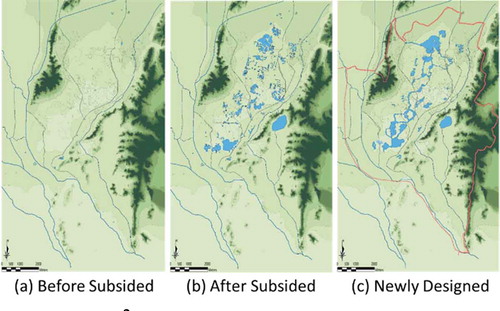
Nature and eco-architecture
Eco-architecture, also known as “green architecture,” “sustainable architecture,” or “green building,” not only skillfully utilizes natural resources, but also brings us a new concept of living, which is an important concept of Design with Nature. Eco-architecture has attracted widespread attention in China. Sustainable development and energy conservation will become an important concept of eco-architectural design or green design, in addition to traditional architectural elements. Eco-architecture design has been the theory, science, and style of building designs, and its themes may run through the whole construction process, guiding project feasibility demonstrations, environmental impact assessments, construction, building operation management, building materials recycling, and beyond.
The first example of eco-architecture is believed to have been built during the energy crises in 1970 s in Minnesota. What has been regarded as “Ouroboros architecture” was constructed in accordance with environmentally friendly principles, minimizing the harm done to the environment through the emissions of its components (Terranova & Tromble, Citation2016). In 1990, the United Kingdom established the first green-architecture environmental assessment method. The United States took the helm in energy and environmental design, building a rating system in 1998 (Azhara et al. Citation2011). China, with its rapid urban sprawl, began to set up an eco-architecture assessment system after 2006, whereby ecological building sites should meet the standards of harmlessness in design, construction, use, and demolition. China will reach an estimated 1.5 billion square meters of green-buildings in 2020. To achieve this goal, construction industries committed to achieving high efficiency, to saving energy, and to the production and use of natural, recyclable, and pollutant-free building materials. It is now public knowledge that eco-architecture has brought us a new concept of green living and embodies a beautiful vision of nature. Green buildings can also be called eco-sustainable buildings, which provide modern living- and working-spaces for human beings without polluting the environment. Green buildings not only reduce energy consumption but also reduce waste, purify the air, protect the natural environment, and improve the quality of life of residents (Baidu Data Citation2014).
Eco-architecture is a crucial part of McHarg’s green-architecture design or “design with nature.” Eco-architecture inspires and encourages communities with an ever-improving quality of life, concurrently protecting valuable resources and nature. Eco-architecture synthesizes time-tested techniques with innovation, promoting individual, and multilateral creativity, which leads to an approach to building that minimizes the harmful effects of construction projects on human health and nature. When we took on the design project for “Flowing Bamboo Reserve” in Qionglai, Sichuan Province, China, we committed to safeguard nature, water, topography, vegetation, and soil by choosing eco-friendly building materials such as bamboo from local forests and construction schemas such as bamboo houses and bamboo tourism parks ().
Nature and society
McHarg argues against those cultural and religious systems of the West that are predicated on a model of territorial conquest. Instead, he says, developers should look toward Shinto, Tao, and Zen, traditions in which the garden is the symbol of society. “Man is only a small player inside the garden,” McHarg wrote. Living in harmony with nature demands that we are future-oriented, nature-oriented, and sustainability-oriented. To be future-oriented, we focus on future technology, new materials, smart city, internet of things (IoT), artificial intelligent (AI), and future transport to create future cities for our society. To be nature-oriented, we mimic nature, understand nature, follow natural laws, and live with nature. As sustainability-oriented designers, we feel this will pose the greatest challenge to our design, especially under the climate change. We need not argue if global warming is true or not, or if it causes increases in global temperature of 1 or 3 degrees. We care more about extreme rainfall, extreme snow storm, extreme flooding and drought, extreme cool and hot weather, and increases in lake water levels due to melting glaciers on a local and regional scale. All these extreme events combine with environmental pollution and resource deterioration to render the sustainability uncertain and put society at risk. Therefore, the current decade poses new challenges for “designing with nature,” since nature has been altered and may not be sustainable. This challenge causes us to believe that we must keep identifying and responding all local threads of extreme conditions in our design of Aifeike Town, Jingmen City, Hubei Province, China. As the mean annual precipitation is 935 mm, an extreme rainfall was 873.2 mm and about the total amount of the mean annual rainfall. In an extreme drought season, lake water levels could decrease by as much as 6.37 m. To respond to these two extreme conditions, we included in the design of the region 1278 hectares of lake area (48% of the total area) with water depth of more than 6.0 m ().
Figure 9. Design of Aifeike Town, Jingmen City, Hubei Province, China with 1278 hectares of lake area (48% of the total area) with water depth of more than 6.0 meters in response to extreme rainfall and drought.
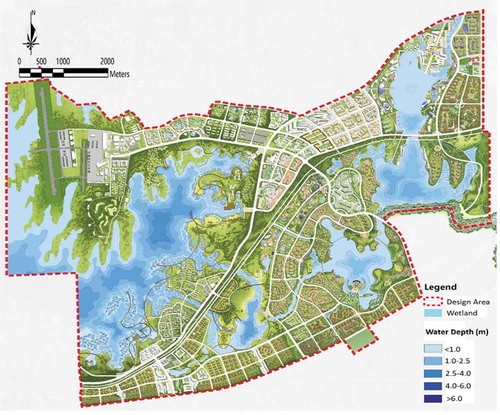
In one particularly evocative passage, McHarg describes how the open air of the countryside and natural areas provide respite for people battling illness and old age. City-centers report the most incidents of heart disease, tuberculosis, diabetes, syphilis, cirrhosis of the liver, amoebic dysentery, bacillary dysentery, and salmonellosis. There are also high occurrences of social disease and mental disease in cities. In China, “in the 21st century the largest accomplishment of art will be to restore the countryside.” We have been following the criteria of “modern farming, rich lifestyle, educated farmers, eco-villages, and water well management” for our designs of new rural areas in China, which center on (1) sustainable farming, (2) improved quality of life for farmers, and (3) water well eco-infrastructure for our design of the Beijing River basin, Jianou City, Fujian Province, China. Since the basin is about 100 km south of Wuyishan National Reserve, one of the most beautiful UN heritage reserves in China, we created 16 new tourist villages for retirees to enjoy clean air and water, in keeping with the Chinese philosopher Zhu Xi’s “keep health methodology,” in the 16-km river basin. We also preserved more than 400 hectares of farmland and turned it into high-value agricultural land to assist farmers. Meanwhile, we re-designed all the villages, adding eco-infrastructure, landscaping, wastewater treatment facilities, and waste management programs. We then allocated more than 200 hectares of wetlands along the river to protect water quality and turn the river into a water sport training resource (). We believe that a good design not only preserves nature, resources, and culture, but also generates profit. This project is estimated to invest about 750 USD million dollars with a net profit of 510 USD million dollars.
Figure 10. Our design of Beijing River basin, Jianou City, Fujian Province, China for the purposes of (a) revitalization of villages, (b) creation of Zhu Xi villas, and (c) protection of farmland.
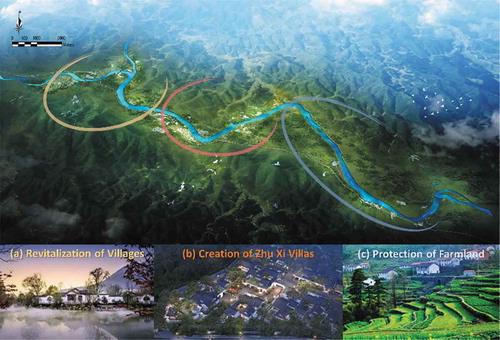
To “design with nature” means to balance cultivation and conservation. For example, we should look for “prime agricultural soils,” which will optimize agricultural productivity and is also our primary commitment in protecting the agriculture land in all our designs. The enactment of the Law on the Prevention and Control of Soil Pollution is expected to provide a more healthy and sustainable business model for the industry of soil pollution control and remediation. In the budget of 2017 announced by the Ministry of Finance, the special budget for prevention and restoration of soil pollution, erosion, and desertification is US$1.6 billion dollars in China (China Economics Network (Citation2017)).
The beauty of one’s living environment does not have a price, so it is called a “non-price benefit.” This “non-price benefit” and the well-being of the environment have reciprocal effects on one another. Residents of an area assign value to a location’s scenery, which includes historic buildings, public meeting places, and green spaces. A highway, for example, is more likely to be built in a place with low social value, and, thus, locations with low social value are more likely to be polluted. Transportation infrastructure creates new values, which, while potentially beneficial to the economy, simultaneously disrupts the beauty of an area and disconnects the ecosystem on either side of the road or rail. Nature-driven design considers the people and nature in the same breath. For example, a highway built parallel to the beach can act as a dune, to protect the people, plants, and wildlife from the sea. Public and private sectors can partner to realize land-use goals. Nature-driven design considers the “benefits” and the “loss” to ecosystems and human communities in order to develop these areas in mutually beneficial ways.
References
- Azhara, S., W. A. Carltona, D. Olsena, and I. Ahmad. 2011. “Building Information Modeling for Sustainable Design and LEED® Rating Analysis.” Automation in Construction 20 (2): 217–10. doi:10.1016/j.autcon.2010.09.019.
- Baidu Data. 2013. “Annual Precipitation of Qingdao.” https://wenku.baidu.com/view/b8383df6c8d376eeaeaa311c.html
- Baidu Data. 2014. “Green Buildings: History and Challenges.” https://wenku.baidu.com/view/2d75a3bf770bf78a65295493.html
- Baidu Data. 2015. “China’s Eco-city Development.” https://wenku.baidu.com/view/2b1fba696edb6f1aff001fad.html
- Bright Energy. 2018. “Reports on China’s Eco-Environment Protection in the Last 40 Years.” http://tech.gmw.cn/ny/2018-12/18/content_32187349.htm
- CEIC. 2018. “China’s Water Resources.” https://www.ceicdata.com/zh-hans/china/water-resource
- Chen, Y., S. Zhang, D. Huang, B. Li, J. Liu, W. Liu, J. Ma, et al. 2017. “The Development of China’s Yangtze River Economic Belt: How to Make It in a Green Way?” Science Bulletin 62 (9): 648–651. doi:10.1016/j.scib.2017.04.009.
- China Economics Network. 2017. “A Report on China’s Desertification Restoration.” http://www.ce.cn/xwzx/gnsz/gdxw/201709/11/t20170911_25881220.shtml
- China News Network. 2018. “A Strategy for China’s Environmental Challenges.” http://www.chinanews.com/gn/2018/01-02/8414171.shtml
- China News Network. 2019. “China’s Renewable Investments to Become More Efficient.” http://www.xinhuanet.com/english/2019-02/04/c_137799096.htm
- Chou, S. K., R. Costanza, P. Earis, K. Hubacek, B. L. Li, Y. Lu, R. Span, et al. 2018. “Priority Areas at the Frontiers of Ecology and Energy.” Ecosystem Health and Sustainability 4 (10): 243–246. doi:10.1080/20964129.2018.1538665.
- Dudley, D. 2019. “China Is Set to Become World’s Renewable Energy Superpower, according to New Report.” https://www.forbes.com/sites/dominicdudley/2019/01/11/china-renewable-energy-superpower/#12815f6e745a
- Ecocity Builders. 2018. “What Is an Ecocity?”. Ecocity Builders, December 09. https://ecocitybuilders.org/what-is-an-ecocity/
- Futurism. 2017. “China Has Officially Started Construction on the World’s First ‘Forest City’.” https://futurism.com/china-has-officially-started-construction-on-the-worlds-first-forest-city
- Guangfu Network. 2018. “Reports on China’s Renewable Energy Development 2018.” http://guangfu.bjx.com.cn/news/20190627/989083.shtml
- Liu, C., and Z. Chen. 2001. Evaluation of the Status of Water Resources in China and Analysis of the Trend of Supply and Demand. Beijing, China: China Water Resources and Hydropower Publishing House.
- Lu, Y. N., V. M. Nebojsa, and S. Anne-Sophie. 2015. “Policy: Five Priorities for the UN Sustainable Development Goals.” Nature 520 (7548): 432–433. doi:10.1038/520432a.
- McHarg, I. L. 1969. Design with Nature, 197. New York, USA: John Wiley & Sons.
- Terranova, C. N., and M. Tromble, eds. 2016. The Routledge Companion to Biology in Art and Architecture, 546. Tylor & Francis Group.
- U.S. Global Investors. 2012. http://www.usfunds.com
- Wang, H., W. Li, B. Li, Y. Lu, Y. Wu, J. Yan, L. Hou, K. Yu, and B. Fu. 2019. Lucid Water and Lush Mountains: China’s National Strategy, Eo-technology and Economics, 247. Nanjing, China: Jiangsu Phoenix Science and Technology Press.
- Wang, H., Y. Huang, and X. Xie. 2016. Theory and Practice of Hydrological Eco-civilization Development, 258. Beijing, China: China Environment Science Press.
- World Bank. 2018. “World Bank Eco-City Definition”. December 10. siteresources.worldbank.org
- Wu, Y., eds. 2016. Sponge City Design: Concept, Technology & Case Study, 287. Nanjing, China: Jiangsu Phoenix Science and Technology Press.
- Wu, Y., N. Wang, and K. Rutchey. 2006. “An Analysis of Spatial Complexity of Ridge and Slough Patterns in the Everglades Ecosystem.” Ecological Complexity 3 (3): 183–192. doi:10.1016/j.ecocom.2005.12.002.
- Wu, Y., and R. Swain, eds. 2018. Eco-city Design: An Ecological Approach for China’s Urbanization, 373. Nanjing, China: Jiangsu Phoenix Science and Technology Press.
- Wu, Y., and W. Liu. 2016 April 24-30. Reports on Ecological Protection in the Yangtze River Economic Zone. Beijing, China: China Association for Science & Technology Press..
- Xie, G. D., C. X. Zhang, L. M. Zhang, W. H. Chen, and S. M. Li. 2015. “A New Methodology for the Evaluation of the Equivalent Factor (EF) per Unit Area (Hectare) of Ecosystem Service Values.” Journal of Natural Resources 30 (8): 1243–1254.

